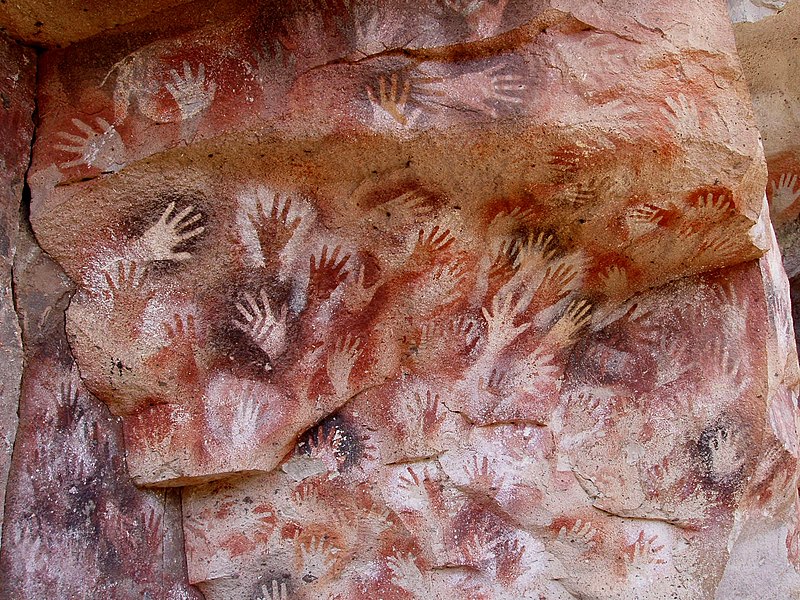Throwing and body coordination
Some features of our body indicate that they are adaptations for the ability to throw objects. Thus, anthropologists suspect that Homo erectus were also able to secure and improve their food intake and protect themselves by targeted throwing.
Questions about the videos:
- What features of our body seem to be adaptations to the targeted throwing of objects?
- Why could these adaptations have come about in the course of our evolutionary history?
Left and right handedness
The targeted throwing of objects, but also the production of tools, not only require certain physical body structures, but also a good coordination and control of arms and hands.
We humans do a lot with our hands. Think about how often and for what purpose you move your hands over the course of a day. Even when we have nothing to do, we often move our hands (turning our thumbs, tapping our fingers, …) or play with things. The ability to use our hands flexibly is common to many primates.
Are you left-handed or right-handed? Or can you use the left and right hands equally well, e.g. for throwing and writing?
Most people prefer to use one of the two hands for activities that require special coordination, strength, and precision (writing, grasping, throwing, …) while the other hand is used to support, balance, or hold. About 85-90% of humanity is right-handed and this distribution seems to be roughly similar in all known populations and cultures. Only about 1% of humanity can use both hands equally well for such activities. Why is that, and why is handedness not rather randomly distributed? Since when did our ancestors have this strong tendency to right-handedness?
Even among amphibians, birds, rodents, and primates, in the wild and in experiments, a slight tendency has been observed for the right limbs to be used for certain tasks, such as targeted manipulation with food and objects. However, this depends on the requirements of the task, and on whether animals have to perform such tasks for survival – the more coordination and concentration is required, the more likely it is to observe that the animals prefer to use one of the two sides, and this tends to be the right hand / paw / leg.
Chimpanzees and other primates, however, do not seem to have such a strong dominance of right-handedness in their populations as we observe in humans.
Why and how could this dominance of right-handedness have arisen in our species over the last 6 million years?
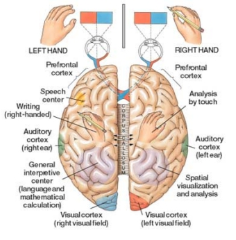
Reading text – Brain and coordination of body movements
A reading text on the evolution of left-right handedness and the role of the brain
Image source: Mariano, CC-BY-SA 2.5
It’s hard to study the handedness of our ancestors. However, based on traces in fossil teeth, the form of fossil bones, and cave paintings researchers conclude that latest Homo heidelbergensis and Homo neanderthalensis had a similar distribution of right-handedness as today’s populations of humans.
These approximately 12,000-year-old handprints in Cuevas de las Manos, Argentina, indicate that most of these artists were right-handed: the right hand held the paint or tools, and the left hand served as the stencil.
Causal map for throwing and coordination of body movements
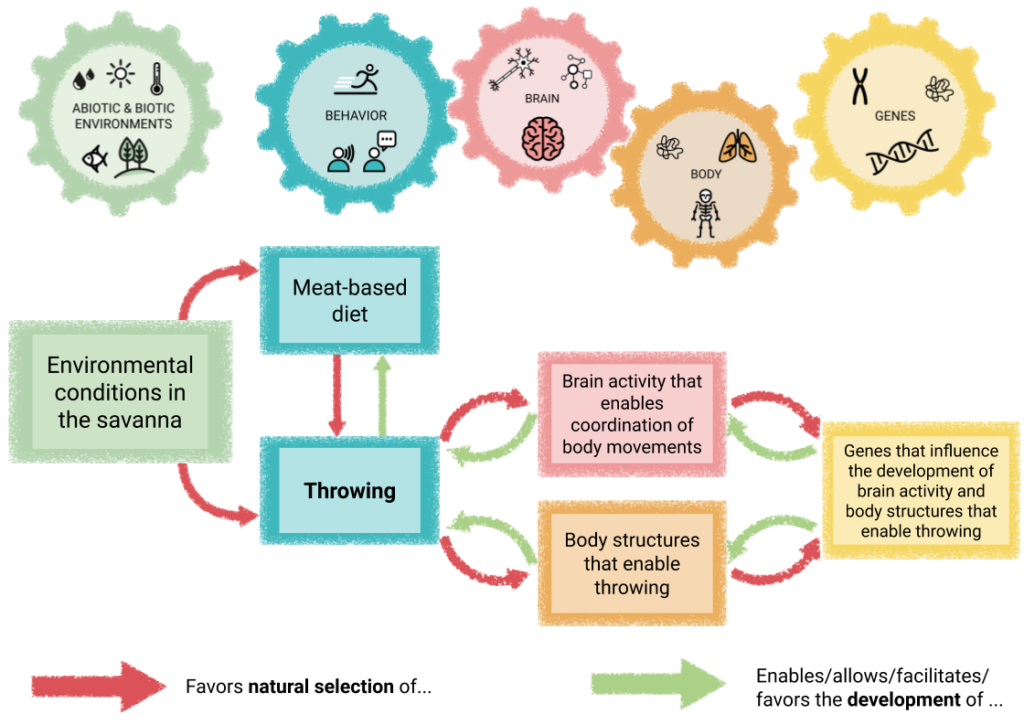
The environmental conditions of the savanna about 2 million years ago increasingly required of the hominid species living there a specializatio on meat-based diet. Those who could effectively exploit the animal food sources of the savanna had better chances of survival and reproduction than others. The savanna’s animal food resources could, in turn, be exploited by those who were good at targeted throwing of stones and other objects. Because this made the killing of prey and protection against predators more effective. Those who had body features that facilitated throwing or made this behavior more efficient, were better at throwing and had better chances of survival and reproduction. Those who were able to coordinate and control their hands and arms were also better in targeted throwing. These coordination abilities are, among others, influenced by the interconnectedness and activity of certain brain regions. Genes that affect these characteristics of the body and brain activity were inherited to offspring, which also had these traits and associated increased chances of survival and reproduction.
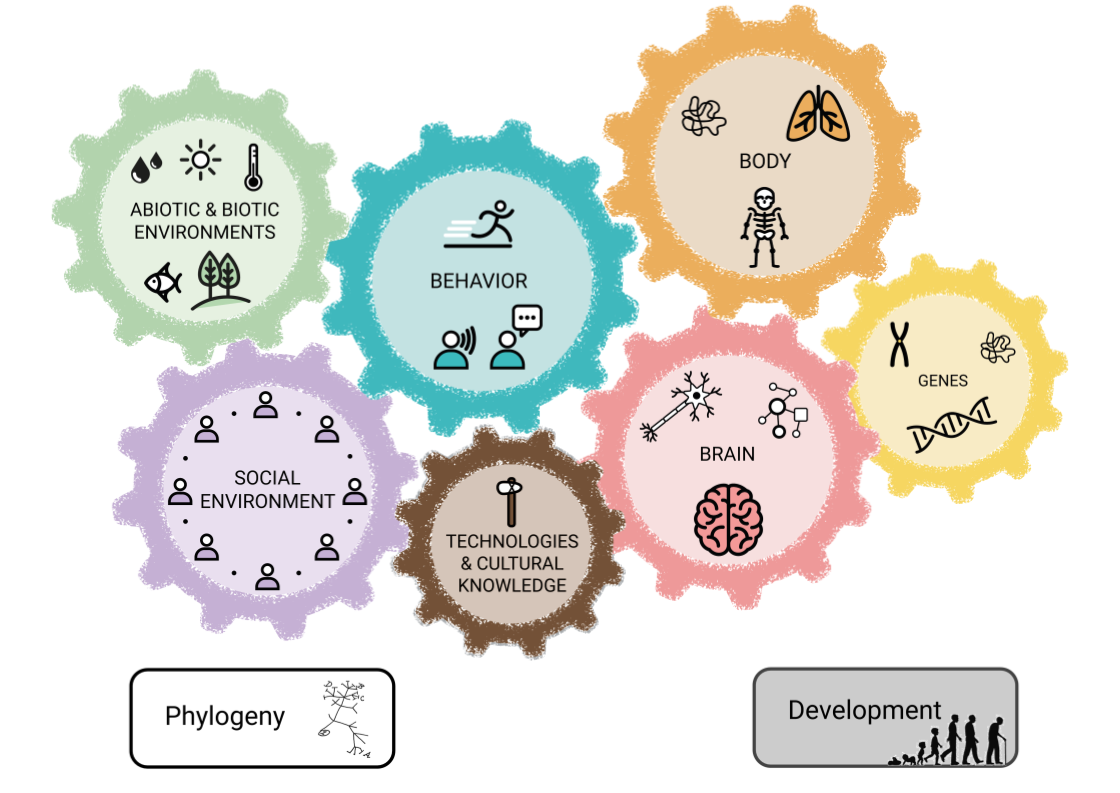
Causal maps on the evolution of human traits
All causal maps on human evolution in one Google slide file
Further reflection questions:
- Could the behavior of upright walking have had an influence in the development of throwing abilities?
- What causes other than genes, body and brain could also have an influence on the development of the ability to throw well?
- Throwing was apparently a helpful strategy for catching prey and defense against predators. Can you think of other ways in which the ability to throw objects could have been helpful to the survival of our ancestors?
Through habitual upright walking, the hands were increasingly free for other purposes, such as the carrying of items and throwing.
The ability for good throwing develops throughout life through learning and practice. Therefore, in addition to genetic inheritance, the social environment and social learning are probably also involved in the transmission and development of this ability to offspring and others in the social group.
Furthermore, anthropologists think that the ability to throw was possilby not only avantageous against prey and predators, but also against conspecifics, both within groups and in competition with other groups. For example, if some in the group became too aggressive and dominant, the ability to throw may have enabled group members to be stronger together against a strong alpha male. This would have been beneficial for conflict resolution in group life. This way, the social environment provided an additional selection pressure on good throwing skills (see also: Life in Groups).
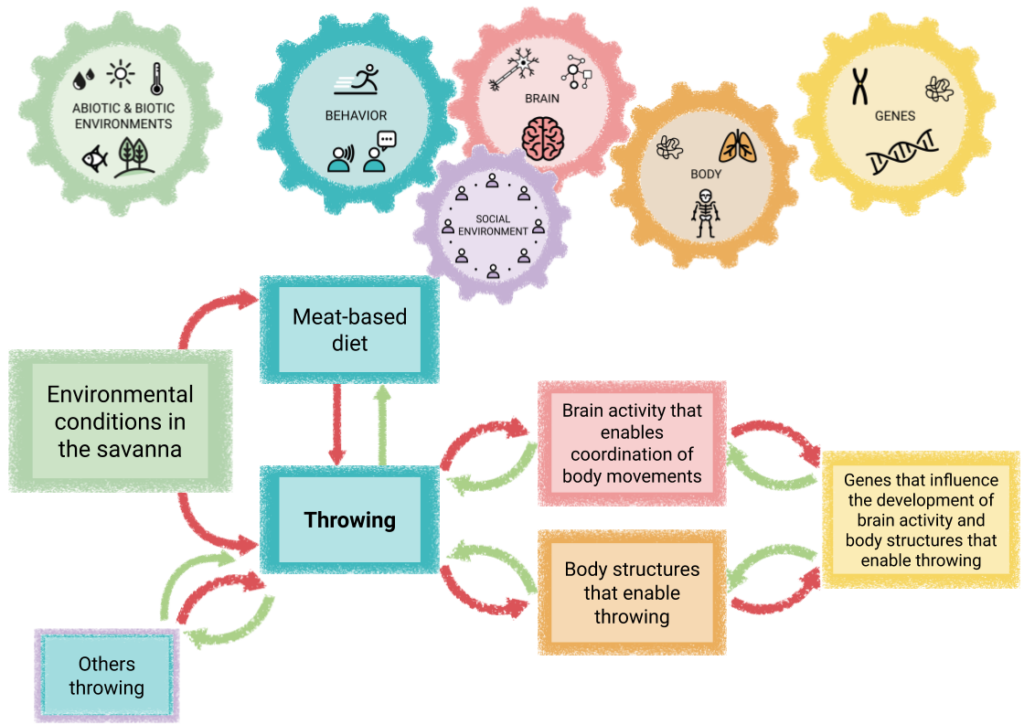
Possible extension of the causal map, to also include the role of the social environment in the development and natural selection of the ability for targeted throwing.
References
- Braccini, S., Lambeth, S., Schapiro, S., & Fitch, W. T. (2010). Bipedal tool use strengthens chimpanzee hand preferences. Journal of Human Evolution, 58(3), 234–241. http://doi.org/10.1016/j.jhevol.2009.11.008
- Corballis, M. C. (2003). From mouth to hand: Gesture, speech, and the evolution of right-handedness. Behavioral and Brain Sciences, 26(2), 199–208. https://doi.org/10.1017/S0140525X03000062
- Forrester, G. S., Quaresmini, C., Leavens, D. A., Mareschal, D., & Thomas, M. S. C. (2013). Human handedness: An inherited evolutionary trait. Behavioural Brain Research, 237(1), 200–206. http://doi.org/10.1016/j.bbr.2012.09.037
- Hopkins, W. D., Phillips, K. A., Bania, A., Calcutt, S. E., Gardner, M., Russell, J., … Schapiro, S. J. (2011). Hand preferences for coordinated bimanual actions in 777 great apes: Implications for the evolution of handedness in Hominins. Journal of Human Evolution, 60(5), 605–611. http://doi.org/10.1016/j.jhevol.2010.12.008
- Hopkins, W. D., Russell, J. L., & Schaeffer, J. A. (2012). The neural and cognitive correlates of aimed throwing in chimpanzees: A magnetic resonance image and behavioural study on a unique form of social tool use. Philosophical Transactions of the Royal Society B: Biological Sciences, 367(1585), 37–47. http://doi.org/10.1098/rstb.2011.0195
- Steele, J., & Uomini, N. (2005). Humans, tools and handedness. Stone Knapping: The Necessary Conditions for a Uniquely Hominin Behavior, 217–239. http://doi.org/10.1056/NEJMra073096
- Steele, J., & Uomini, N. (2009). Can the archaeology of manual specialization tell us anything about language evolution? A survey of the state of play. Cambridge Archaeological Journal, 19(1), 97–110. http://doi.org/10.1017/S0959774309000067
- Toth, N. (1985). Archaeological evidence for preferential right-handedness in the lower and middle pleistocene, and its possible implications. Journal of Human Evolution, 14(6), 607–614. http://doi.org/10.1016/S0047-2484(85)80087-7
- Uomini, N. T. (2009). The prehistory of handedness: Archaeological data and comparative ethology. Journal of Human Evolution, 57(4), 411–419. http://doi.org/10.1016/j.jhevol.2009.02.012

